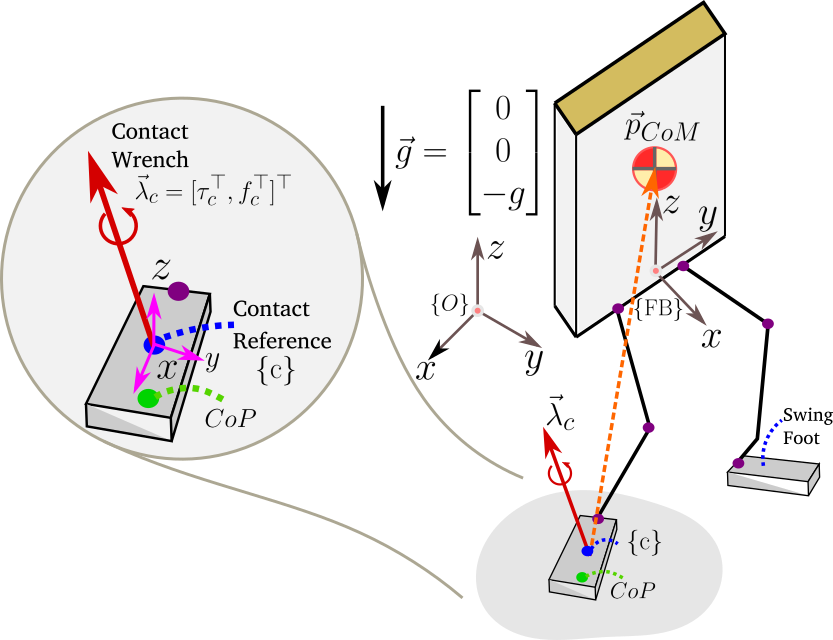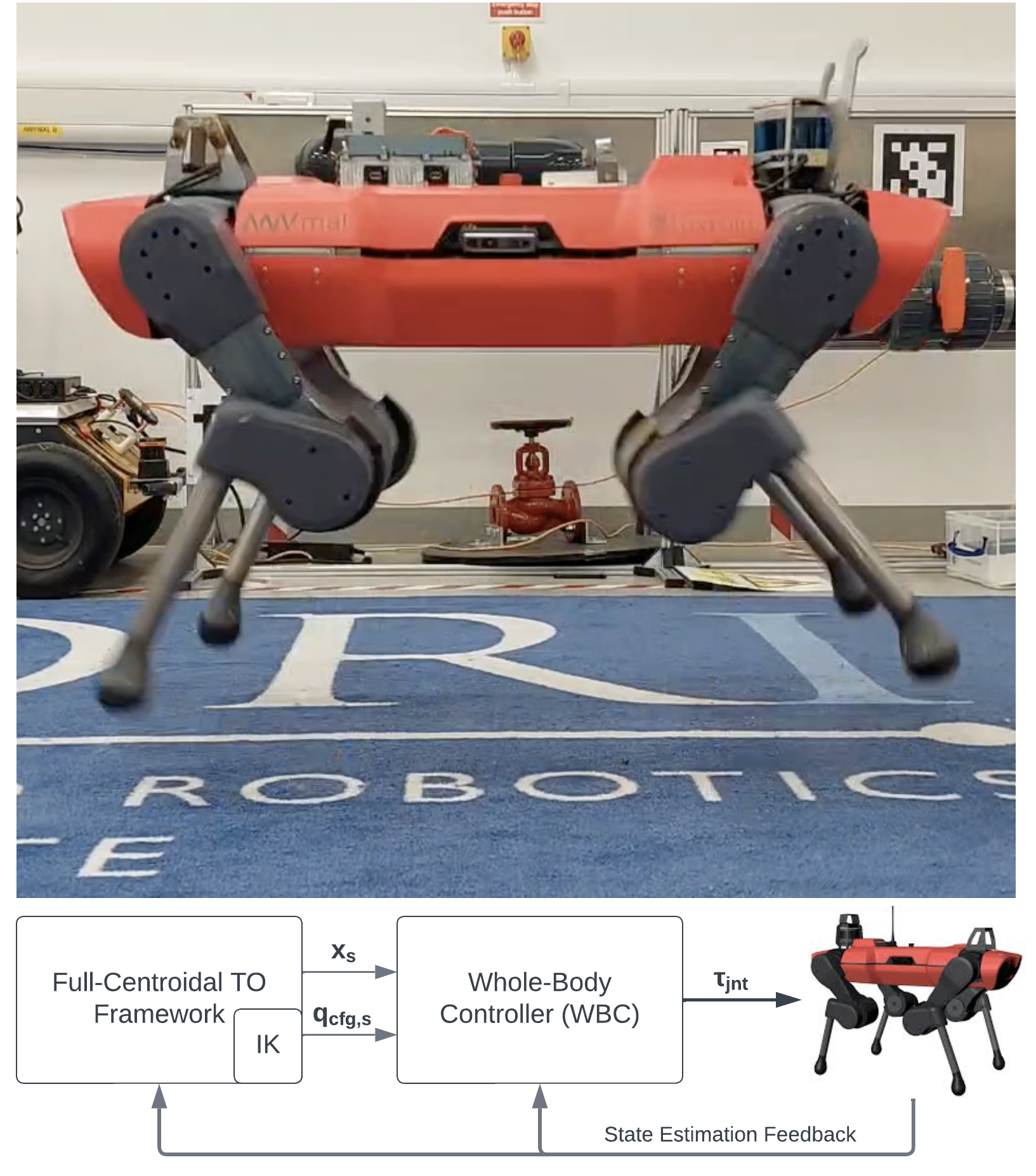Moving past point-contacts: Extending the ALIP model to humanoids with non-trivial feet using hierarchical, full-body momentum control

0

Sign in to get full access
Overview
- This research paper explores extending the Artificial Lateral Inverted Pendulum (ALIP) model, commonly used for bipedal robot control, to handle robots with more complex feet.
- The authors propose a hierarchical, full-body momentum control framework to enable stable and agile locomotion for humanoid robots with non-trivial feet.
- Key aspects include leveraging the ALIP model, incorporating whole-body dynamics, and using a hierarchical control structure.
Plain English Explanation
The paper focuses on improving the control and stability of humanoid robots as they walk and move around. Traditionally, researchers have used a simplified model called the Artificial Lateral Inverted Pendulum (ALIP) to control the balance and movement of bipedal robots.
However, the ALIP model assumes the robot has simple "point" feet, which doesn't accurately represent real-world humanoid robots that have more complex foot shapes. To address this, the authors developed a new control framework that extends the ALIP model to work with humanoids that have non-trivial feet.
The key idea is to use a hierarchical control structure that considers the full dynamics of the entire robot body, not just the simplified ALIP model. This hierarchical approach allows the control system to coordinate all the different joints and body parts to maintain balance and execute desired motions, even for robots with more advanced feet designs.
By incorporating the complete robot dynamics, rather than just the simplified ALIP model, the authors were able to demonstrate more stable and agile locomotion for humanoid robots with non-point feet. This represents an important step forward in enabling these robots to navigate real-world environments more effectively.
Technical Explanation
The paper proposes a hierarchical, full-body momentum control framework to enable stable and agile locomotion for humanoid robots with non-trivial feet. This extends the well-known Artificial Lateral Inverted Pendulum (ALIP) model, commonly used for bipedal robot control, to handle robots with more complex foot shapes.
The key aspects of the proposed approach include:
-
Leveraging the ALIP Model: The authors build on the ALIP model as a simplified representation of the robot's balance and dynamics. This provides a foundation for control, while the hierarchical framework allows extending it to handle more realistic robot feet.
-
Incorporating Whole-Body Dynamics: Instead of just focusing on the simplified ALIP model, the control framework incorporates the full dynamics of the robot's body, including all the joints and links. This enables coordinated control of the entire system for stable and agile locomotion.
-
Hierarchical Control Structure: The control is organized in a hierarchical manner, with higher-level tasks like balance and motion planning coordinating the lower-level joint-level control. This separation of concerns allows the system to effectively manage the complexities of a humanoid robot with non-trivial feet.
The authors demonstrate the effectiveness of their approach through simulations and experiments with a humanoid robot model. The results show that the proposed framework can achieve stable and agile locomotion, even for robots with more advanced foot designs that go beyond the simple point-contact assumptions of the original ALIP model.
Critical Analysis
The paper presents a well-designed and thorough approach to extending the ALIP model for humanoid robots with non-trivial feet. The key strength is the incorporation of the full-body dynamics and the hierarchical control structure, which allows the system to effectively manage the increased complexity compared to the original ALIP model.
One potential limitation is the reliance on simulations and a single robot model for evaluation. While the results are promising, further validation on physical robot platforms with diverse foot designs would strengthen the claims and provide additional insights.
Additionally, the authors do not explore the limits of the approach or discuss potential failure modes. Understanding the boundaries and robustness of the control framework in the face of challenging scenarios or disturbances would be valuable for assessing its real-world applicability.
Overall, this research represents an important advancement in enabling more agile and stable locomotion for humanoid robots, particularly those with non-trivial foot designs. The hierarchical, full-body momentum control approach is a significant step forward and could inspire further innovations in this area.
Conclusion
This paper presents a hierarchical, full-body momentum control framework that extends the well-known ALIP model to enable stable and agile locomotion for humanoid robots with non-trivial feet. By incorporating the complete robot dynamics and using a hierarchical control structure, the authors demonstrate the ability to achieve effective locomotion even for robots with more advanced foot designs.
The proposed approach is a valuable contribution to the field of bipedal robot control, as it addresses the limitations of the original ALIP model and paves the way for humanoid robots to navigate real-world environments more effectively. While further validation and exploration of the framework's boundaries would be beneficial, this research represents an important step forward in advancing the capabilities of humanoid robotics.
This summary was produced with help from an AI and may contain inaccuracies - check out the links to read the original source documents!
Related Papers


0
Moving past point-contacts: Extending the ALIP model to humanoids with non-trivial feet using hierarchical, full-body momentum control
Victor C. Paredes, Daniel A. Hagen, Samuel W. Chesebrough, Riley Swann, Denis Garagic, Ayonga Hereid
The Angular-Momentum Linear Inverted Pendulum (ALIP) model is a promising motion planner for bipedal robots. However, it relies on two assumptions: (1) the robot has point-contact feet or passive ankles, and (2) the angular momentum around the center of mass, known as centroidal angular momentum, is negligible. This paper addresses the question of whether the ALIP paradigm can be applied to more general bipedal systems with complex foot geometry (e.g., flat feet) and nontrivial torso/limb inertia and mass distribution (e.g., non-centralized arms). In such systems, the dynamics introduce non-negligible centroidal momentum and contact wrenches at the feet, rendering the assumptions of the ALIP model invalid. This paper presents the ALIP planner for general bipedal robots with non-point-contact feet through the use of a task-space whole-body controller that regulates centroidal momentum, thereby ensuring that the robot's behavior aligns with the desired template dynamics. To demonstrate the effectiveness of our proposed approach, we conduct simulations using the Sarcos Guardian XO robot, which is a hybrid humanoid/exoskeleton with large, offset feet. The results demonstrate the practicality and effectiveness of our approach in achieving stable and versatile bipedal locomotion.
Read more8/13/2024


0
Demonstrating a Robust Walking Algorithm for Underactuated Bipedal Robots in Non-flat, Non-stationary Environments
Oluwami Dosunmu-Ogunbi, Aayushi Shrivastava, Jessy W Grizzle
This work explores an innovative algorithm designed to enhance the mobility of underactuated bipedal robots across challenging terrains, especially when navigating through spaces with constrained opportunities for foot support, like steps or stairs. By combining ankle torque with a refined angular momentum-based linear inverted pendulum model (ALIP), our method allows variability in the robot's center of mass height. We employ a dual-strategy controller that merges virtual constraints for precise motion regulation across essential degrees of freedom with an ALIP-centric model predictive control (MPC) framework, aimed at enforcing gait stability. The effectiveness of our feedback design is demonstrated through its application on the Cassie bipedal robot, which features 20 degrees of freedom. Key to our implementation is the development of tailored nominal trajectories and an optimized MPC that reduces the execution time to under 500 microseconds--and, hence, is compatible with Cassie's controller update frequency. This paper not only showcases the successful hardware deployment but also demonstrates a new capability, a bipedal robot using a moving walkway.
Read more9/9/2024


0
New!Real-time Coupled Centroidal Motion and Footstep Planning for Biped Robots
Tara Bartlett, Ian R. Manchester
This paper presents an algorithm that finds a centroidal motion and footstep plan for a Spring-Loaded Inverted Pendulum (SLIP)-like bipedal robot model substantially faster than real-time. This is achieved with a novel representation of the dynamic footstep planning problem, where each point in the environment is considered a potential foothold that can apply a force to the center of mass to keep it on a desired trajectory. For a biped, up to two such footholds per time step must be selected, and we approximate this cardinality constraint with an iteratively reweighted $l_1$-norm minimization. Along with a linearizing approximation of an angular momentum constraint, this results in a quadratic program can be solved for a contact schedule and center of mass trajectory with automatic gait discovery. A 2 s planning horizon with 13 time steps and 20 surfaces available at each time is solved in 142 ms, roughly ten times faster than comparable existing methods in the literature. We demonstrate the versatility of this program in a variety of simulated environments.
Read more9/17/2024


0
Momentum-Aware Trajectory Optimisation using Full-Centroidal Dynamics and Implicit Inverse Kinematics
Aristotelis Papatheodorou, Wolfgang Merkt, Alexander L. Mitchell, Ioannis Havoutis
The current state-of-the-art gradient-based optimisation frameworks are able to produce impressive dynamic manoeuvres such as linear and rotational jumps. However, these methods, which optimise over the full rigid-body dynamics of the robot, often require precise foothold locations apriori, while real-time performance is not guaranteed without elaborate regularisation and tuning of the cost function. In contrast, we investigate the advantages of a task-space optimisation framework, with special focus on acrobatic motions. Our proposed formulation exploits the system's high-order nonlinearities, such as the nonholonomy of the angular momentum, in order to produce feasible, high-acceleration manoeuvres. By leveraging the full-centroidal dynamics of the quadruped ANYmal C and directly optimising its footholds and contact forces, the framework is capable of producing efficient motion plans with low computational overhead. Finally, we deploy our proposed framework on the ANYmal C platform, and demonstrate its true capabilities through real-world experiments, with the successful execution of high-acceleration motions, such as linear and rotational jumps. Extensive analysis of these shows that the robot's dynamics can be exploited to surpass its hardware limitations of having a high mass and low-torque limits.
Read more9/14/2024